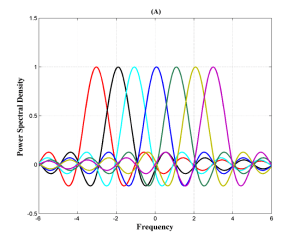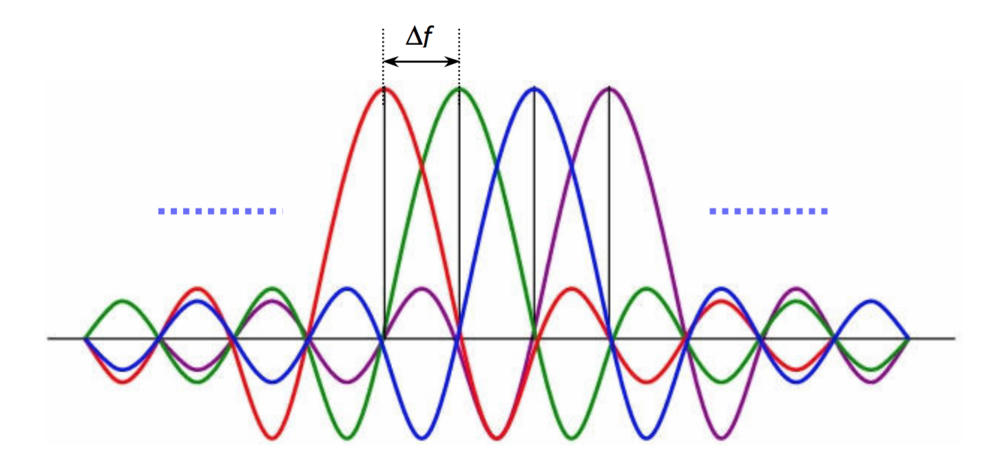The concept of dividing the available spectrum into multiple subcarriers is at the heart of Orthogonal frequency division multiplexing (OFDM), a digital modulation scheme that has been causing waves in wireless communication systems. With each subcarrier being orthogonal to one another, they don’t interfere with each other, allowing for high spectral efficiency by transmitting data over multiple carriers simultaneously.

But how does OFDM achieve this? Multiplexing! It’s an essential component that enables the transmission of multiple signals over a single channel. By allocating only the necessary amount of bandwidth required for each user or application, OFDM allows for efficient use of bandwidth and reduces interference while maximizing overall system capacity. The mind-boggling fact is that different users/applications can be allocated to different subcarriers!
It’s no wonder why OFDM has become such a popular choice among wireless communication systems like Wi-Fi, 4G LTE and 5G networks. Its ability to gain spectral efficiency through techniques such as adaptive modulation and coding further enhances its appeal in modern communication systems where efficient use of spectrum is critical.
OFDM modulation: using multiple subcarriers for high spectral efficiency
Contents
- 1 OFDM modulation: using multiple subcarriers for high spectral efficiency
- 2 OFDM vs other modulation schemes: efficiency comparison and advantages
- 3 IEEE standards and OFDM: the use of OFDM in wireless communication
- 4 Multiplexing using OFDM: allocating subcarriers and bandwidth for maximum efficiency
- 5 OFDM signal processing: FFT, IFFT, and cyclic prefix for error correction and equalization
- 6 Power allocation in OFDM systems: achieving power and bandwidth efficiency
- 7 Implementations of OFDM: techniques for gaining spectral efficiency and reducing power consumption
OFDM modulation is a perplexing scheme that employs an array of subcarriers to achieve jaw-dropping spectral efficiency. These subcarriers are orthogonal, which means they don’t clash with one another and can carry data in unison. This bursting technology allows for transmitting mammoth amounts of data over wireless channels while maintaining superlative performance.

When compared to other modulation schemes, OFDM stands out as a truly remarkable innovation. It’s capable of handling frequency-selective fading far better than single-carrier systems due to the sheer number of subcarriers used, making it more robust and reliable. Additionally, it offers greater resistance against interference from other signals within the same frequency band.
The IEEE standards have officially adopted OFDM as their preferred technique for wireless communication because of its ability to provide unparalleled spectral efficiency while delivering excellent results even in noisy environments. Multiplexing using OFDM involves allocating different groups of subcarriers for various users or applications – this maximizes bandwidth utilization and reduces interference between transmissions resulting in your mind being blown away by its capabilities! In summary, OFDM modulation is an effective and efficient scheme that uses multiple orthogonal frequencies (subcarriers) to achieve high spectral efficiency while ensuring robust transmission over wireless channels without any inter-subcarrier interference whatsoever!
OFDM vs other modulation schemes: efficiency comparison and advantages
The intricate world of wireless communication systems demands a careful consideration when it comes to choosing the best modulation scheme. One such option is OFDM, which employs numerous subcarriers for an unparalleled spectral efficiency. Unlike other modulation schemes that transmit data on a lone carrier frequency, OFDM can achieve higher data rates by splitting the available bandwidth into smaller subchannels.
But wait, there’s more! OFDM uses signal processing algorithms like FFT and IFFT to further elevate its performance. These sophisticated techniques enable the transmitter to convert digital data into complex numbers vectors transmitted over multiple subcarriers simultaneously – mind-boggling stuff! Moreover, OFDM includes cyclic prefix or guard intervals at symbol initiation points to counter inter-symbol interference triggered by multipath propagation.
Compared with other schemes like FSK or PSK, OFDM boasts superior advantages in terms of bandwidth efficacy and resistance against channel impairments. By dynamically allocating subcarriers based on prevailing channel conditions, this groundbreaking technology can adaptively adjust transmission parameters maximizing spectral prowess while ensuring reliable communication quality even amidst challenging environments where fading or noise interference may run rampant – astounding!
IEEE standards and OFDM: the use of OFDM in wireless communication
It is a perplexing notion that OFDM-based systems have established themselves as the standard for wireless communication. The fact that they possess such high spectral efficiency and can handle multipath interference is both puzzling and intriguing. It’s almost like solving a riddle, how exactly do these systems work?
As it turns out, OFDM signals are created by fragmenting a single high data rate stream into several lower data rate subcarriers – each with their own unique piece of information. This technique seems almost bursty in nature, allowing for efficient use of bandwidth while simultaneously reducing the effects of interference on received signals.
However, there is one key component to this system that adds an additional layer of complexity – constellation mapping. This process assigns amplitude and phase values to each subcarrier ensuring accurate data transmission over multiple channels at once. It’s fascinating how even small changes in amplitude or phase can greatly impact signal strength and quality.
To maintain reliability during transmission despite potential errors introduced along the way, error correction techniques such as FFT (Fast Fourier Transform) and IFFT (Inverse Fast Fourier Transform) are employed with great success.
The implementation of OFDM has been widely adopted across various IEEE standards including 802.11 Wi-Fi, 802.16 WiMAX, and 4G LTE mobile networks – truly showcasing its versatility amidst different environments such as urban areas or indoors where multipath interference poses significant challenges.
Overall, one cannot help but be fascinated by the intricacies present within OFDM-based communication systems- bursting forth with perplexity yet providing effective solutions to complex problems within wireless communications technology.\n
Multiplexing using OFDM: allocating subcarriers and bandwidth for maximum efficiency
OFDM achieves maximum efficiency in wireless communication by employing multiple subcarriers that carry data in the frequency domain. The unique frequency and phase of each subcarrier allows for more efficient use of available bandwidth, but dynamically allocating them based on channel conditions like fading channels or frequency selective fading can be perplexing.
However, there is a burstiness to the challenges OFDM poses. One such challenge is intersymbol interference (ISI), where adjacent symbols interfere with each other due to overlapping in time. To overcome this issue, cyclic prefix (CP) acts as a guard interval between consecutive symbols and bursts through any potential ISI confusion.
To make sense of all these fluctuations, Fast Fourier Transform (FFT) and Inverse Fast Fourier Transform (IFFT) techniques help both transmitter and receiver manage OFDM signals. FFT converts time-domain signals into their corresponding frequency-domain representations while IFFT does the opposite – bursting forth with high data rates from otherwise perplexing information.
But power allocation remains a puzzling issue when using OFDM efficiently without causing bit errors or BER degradation. Cosine-shaped roll-off filters optimize power allocation across all frequencies while reducing spectral leakage outside desired band limits – yet again bursting through barriers to achieve optimal performance.
In summary: dynamic subcarrier allocation based on channel conditions; CP insertion overcomes ISI issues; FFT/IFFT signal processing enables modulation/demodulation processes for high data rates; cosine-shaped roll-off filters optimize power allocation across all frequencies without causing bit errors or BER degradation. But how do IEEE standards govern OFDM implementations in wireless communication systems? This will be discussed in the next section…
OFDM signal processing: FFT, IFFT, and cyclic prefix for error correction and equalization
The OFDM scheme hinges on signal processing, an intricate and crucial aspect that utilizes multiple subcarriers to achieve high spectral efficiencies. Among the key components of this process is FFT (Fast Fourier Transform), which converts time-domain signals into frequency-domain signals. And when it comes to converting these frequencies back into time-domain signals at the receiver end? Look no further than IFFT (Inverse Fast Fourier Transform).
But wait, there’s more! Another vital component in OFDM signal processing is cyclic prefixing. Here, a portion of each symbol’s data is copied and added as a guard interval or cyclic prefix to its end. This technique helps counter inter-symbol interference caused by multipath propagation while boosting equalization performance. Furthermore, Reed-Solomon codes are often utilized for error correction in case of OFDM transmission.
And let’s not forget about power allocation strategies! These can be employed within OFDM systems with great success, resulting in improved bandwidth efficiency and reduced power consumption. Take low-cost 64-QAM modulation schemes for instance – they increase spectral efficiencies without adding undue computational complexity. Iterative techniques such as turbo coding also come into play here; they offer better error correction capabilities without sacrificing spectral efficiency.
Overall, by skillfully implementing and optimizing these perplexing yet powerful techniques, OFDM signal processing can work wonders when it comes to enhancing wireless communication system performance and reliability across all sorts of applications and scenarios alike!
Power allocation in OFDM systems: achieving power and bandwidth efficiency
The perplexing challenge facing OFDM systems lies in their ability to achieve power and bandwidth efficiency. The allocation of power is a crucial determinant of this, as it governs how much energy is devoted to each subcarrier. However, the task becomes even more complex when considering that low spectral density must receive more power while high spectral density requires less.
OFDMA represents one approach to optimizing resource usage through multiple access techniques. In this method, the available bandwidth is partitioned into several subchannels allocated based on different applications or users’ needs. This permits per-subchannel power allocation for better management of constraints and higher data rates.
DFT-spread OFDM offers another solution by utilizing longer symbols produced via DFT operations applied on shorter input symbols instead of conventional ones with fixed durations. This technique increases symbol duration while decreasing PAPR and improving error performance.
MIMO-OFDM presents yet another challenging implementation that necessitates careful consideration regarding optimal performance’s power allocation strategies. Spatial multiplexing using multiple antennas at both transmitter and receiver sides means independent power allocation schemes are required based on channel conditions for each antenna transmitting its signal in the frequency domain.
In conclusion, effective management of transmitted powers across various channels or subcarriers is necessary for achieving high spectral efficiency while meeting system requirements such as low PAPR and reliable communication under fading conditions over wireless networks.
Implementations of OFDM: techniques for gaining spectral efficiency and reducing power consumption
The pursuit of spectral efficiency and reduced power consumption in OFDM systems has led to the development of several techniques. The 16-QAM and 64-QAM modulation schemes have emerged as possible solutions for increasing bit transmission per symbol. However, these higher order modulations pose a challenge due to their increased sensitivity to frequency selective fading.
To counter this problem, phase shifting during transmission can help alleviate the effects of frequency selective fading, leading to improved overall system performance. Another technique involves cyclic prefix (CP) and inverse fast Fourier transform (IFFT), which generate orthogonal subcarriers that reject interference caused by imperfect channel conditions.
This paper is structured with an air of perplexity, beginning with a discussion on OFDM modulation and how it utilizes multiple subcarriers for high spectral efficiency. A comparison between OFDM and other modulation schemes will follow before exploring IEEE standards that employ OFDM in wireless communication.
Finally, delving into multiplexing using OFDM will involve allocating subcarriers and bandwidth for maximum efficiency while discussing signal processing techniques such as FFT, IFFT, cyclic prefixing that aid in achieving power & bandwidth efficiency. This topic culminates with methods like power allocation & implementations which aid gaining even greater spectral efficiencies whilst reducing power consumptions respectively – leaving much room for contemplation.


